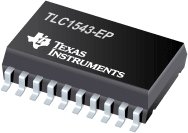TLC1543-EP 具有串行控制 11 路模拟输入的增强型产品 10 位模数转换器
 The TLC1542-EP and TLC1543-EP are CMOS 10-bit switched-capacitor successive-approximation analog-to-digital converters. These devices have three inputs, a 3-state output chip select (CS)\, input/output clock (I/O CLOCK), address input (ADDRESS), and data output (DATA OUT)] that provide a direct 4-wire interface to the serial port of a host processor. The TLC1542-EP and TLC1543-EP allow high-speed data transfers from the host.
The TLC1542-EP and TLC1543-EP are CMOS 10-bit switched-capacitor successive-approximation analog-to-digital converters. These devices have three inputs, a 3-state output chip select (CS)\, input/output clock (I/O CLOCK), address input (ADDRESS), and data output (DATA OUT)] that provide a direct 4-wire interface to the serial port of a host processor. The TLC1542-EP and TLC1543-EP allow high-speed data transfers from the host.
In addition to a high-speed A/D converter and versatile control capability, the TLC1542-EP and TLC1543-EP have an on-chip 14-channel multiplexer that can select any one of 11 analog inputs or any one of three internal self-test voltages. The sample-and-hold function is automatic. At the end of the A/D conversion, the end-of-conversion (EOC) output goes high to indicate that conversion is complete.
|
TLC1543-EP |
| Resolution (Bits) |
10 |
| Sample Rate (max) (SPS) |
38kSPS |
| # Input Channels |
11 |
| Interface |
Serial SPI Interface |
| DNL (Max) (+/-LSB) |
1 |
| INL (Max) (+/-LSB) |
1 |
| Input Range |
Vref |
| Power Consumption (Typ) (mW) |
4 |
| Reference Mode |
Ext |
| Architecture |
SAR |
| Rating |
HiRel Enhanced Product |
| Operating Temperature Range (C) |
-40 to 125 |
| Pin/Package |
20SOIC |
TLC1543-EP 特性
- Controlled Baseline
- One Assembly/Test Site, One Fabrication Site
- Extended Temperature Performance of –40°C to 125°C
- Enhanced Diminishing Manufacturing Sources (DMS) Support
- Enhanced Product Change Notification
- Qualification Pedigree
- 10-Bit Resolution A/D Converter
- 11 Analog Input Channels
- Three Built-In Self-Test Modes
- Inherent Sample-and-Hold Function
- Total Unadjusted Error . . . ±1 LSB Max
- On-Chip System Clock
- End-of-Conversion (EOC) Output
- Terminal Compatible With TLC542
- CMOS Technology
TLC1543-EP 芯片订购指南
| 器件 |
状态 |
温度 (oC) |
价格(美元) |
封装 | 引脚 |
封装数量 | 封装载体 |
丝印标记 |
| TLC1543QDWREP |
ACTIVE |
-40 to 125 |
3.40 | 100u |
SOIC (DW) | 20 |
2000 | LARGE T&R |
|
| V62/04647-01XE |
ACTIVE |
-40 to 125 |
3.40 | 100u |
SOIC (DW) | 20 |
2000 | LARGE T&R |
|
TLC1543-EP 质量与无铅数据
| 器件 |
环保计划* |
铅/焊球涂层 |
MSL 等级/回流焊峰 |
环保信息与无铅 (Pb-free) |
DPPM / MTBF / FIT 率 |
| TLC1543QDWREP |
Green (RoHS & no Sb/Br) |
CU NIPDAU |
Level-1-260C-UNLIM |
TLC1543QDWREP |
TLC1543QDWREP |
| V62/04647-01XE |
Green (RoHS & no Sb/Br) |
CU NIPDAU |
Level-1-260C-UNLIM |
V62/04647-01XE |
V62/04647-01XE |
TLC1543-EP 工具与软件
TLC1543-EP 应用技术支持与电子电路设计开发资源下载
- TLC1543-EP 数据资料 dataSheet 下载.PDF
- TI 德州仪器数据转换器选型与价格参考 . xls
- Determining Minimum Acquisition Times for SAR ADCs, part 2
- Determining Minimum Acquisition Times for SAR ADCs, part 1
 The TLC1542-EP and TLC1543-EP are CMOS 10-bit switched-capacitor successive-approximation analog-to-digital converters. These devices have three inputs, a 3-state output chip select (CS)\, input/output clock (I/O CLOCK), address input (ADDRESS), and data output (DATA OUT)] that provide a direct 4-wire interface to the serial port of a host processor. The TLC1542-EP and TLC1543-EP allow high-speed data transfers from the host.
The TLC1542-EP and TLC1543-EP are CMOS 10-bit switched-capacitor successive-approximation analog-to-digital converters. These devices have three inputs, a 3-state output chip select (CS)\, input/output clock (I/O CLOCK), address input (ADDRESS), and data output (DATA OUT)] that provide a direct 4-wire interface to the serial port of a host processor. The TLC1542-EP and TLC1543-EP allow high-speed data transfers from the host.